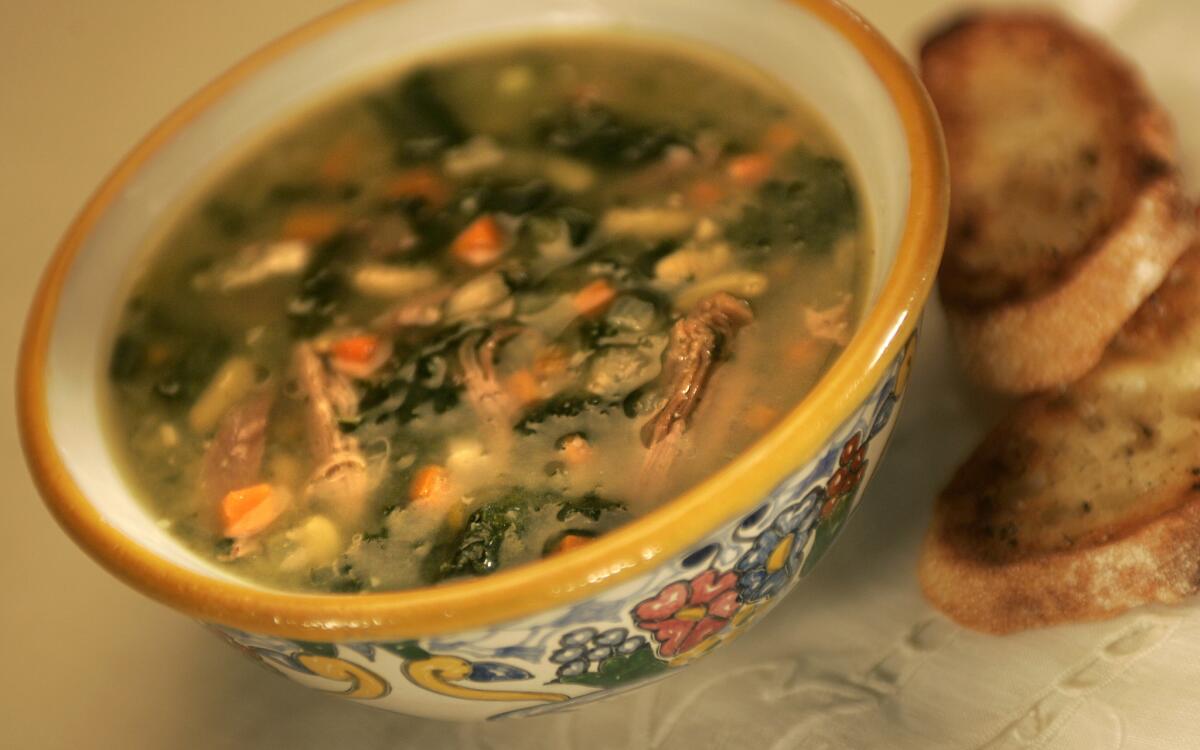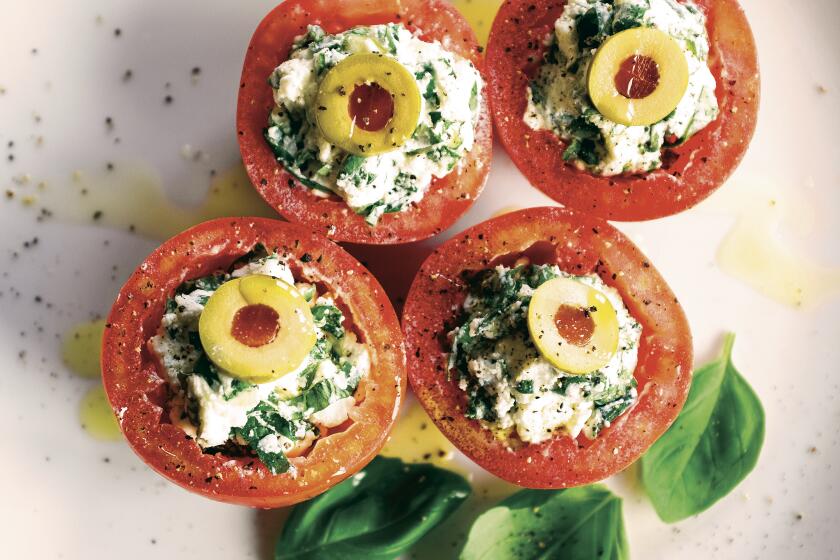Flageolet bean, kale and duck soup

- Share via
What could be more pedestrian -- and less glamorous -- than onions, carrots and celery? Yet mirepoix, the simple trinity of ordinary vegetables cut into even dice, forms the foundation of a tremendous number of dishes. Knowing how to make and use mirepoix is one of the essentials of classical French cooking. But it’s so important in all cooking that you’ve probably made it a thousand times without necessarily knowing it.
Sweat mirepoix in butter or olive oil, and it forms the basis of sauces, soups, risottos and braises. Cut into bigger cubes, the vegetables begin stocks or stews. Cut more finely, they start sauces or add flavor to roasts or soups. Diced and added at the end, they brighten braises or form their own garnish -- some cooks even add them twice, as a foundation and later, to refresh the flavors.
*
Bare essentials
BASIC mirepoix, because it is so fundamental, acts almost literally as a foundation. It provides the ground floor for other layers -- beans in a soup, meat in a braise -- to build upon.
Carrots, onions and celery may be everyday vegetables, but they are also aromatics, which means they enhance the natural flavors and aromas of foods. By cooking them slowly together, you’re releasing these flavors and their liquids and creating a base for the dish.
Mirepoix is traditionally composed of 50% onions, 25% carrots and 25% celery. This ratio is important because aromatics, like most flavors, function proportionally. A 75% carrot ratio, for example, would make a tasty puree of carrot soup but a questionable flavor base.
You can vary the ingredients, adding garlic or shallots or fennel or ham, substituting parsnips for carrots to make the white mirepoix used in fish fumets (concentrated broths) or light stocks, adding lemon grass or chiles for regional cuisines. Classical French cooking uses butter, while Provencal cooking relies more on olive oil -- as does Italian and Spanish recipes. The cooking of Southwest France, on the other hand, uses duck or goose fat. Elsewhere in the world, you might find peanut oil or ghee.
French mirepoix is so essential that many cooking cultures depend on a variation of it: Italian food relies on soffrito, Portugal has refogado, Spanish cooks use sofrito, Indonesians have bumbu.
*
Dice with precision
SO, how to cut it? Size matters. A lot.
In classical cooking, and in the boot camp sometimes called culinary school, mirepoix is cut finely, showcasing painfully exact cuts: brunoise (eighth-inch cubes) or macedoine (quarter-inch cubes). Though chopping vegetables into tiny dice may seem a bit excessive to the home cook, there is a reason to have nice cuts for your mirepoix. Uniformity of cuts means uniformity of cooking time, which is important.
How you cut a mirepoix varies from dish to dish and depends on such factors as the cooking technique you’ll use, the flavor desired and the length of cooking time.
A simple and relatively quick soup, such as a satisfying bean, duck and kale soup, calls for a medium-dice mirepoix because you want the vegetable pieces to be large enough to simmer without breaking apart but small enough to avoid upstaging the other ingredients. A long-simmering stew or braise would call for larger cuts, perhaps half-inch dice.
Dishes that are prepared quickly and use mirepoix for aesthetic reasons as well as those of taste usually call for very fine dice. Baked striped bass as well as chicken roulade call for very finely diced vegetables, which allows them to remain intact. It also makes for relatively simple presentation as the mirepoix can (in the case of the fish) become decoration and sauce, as well as the platform on which to bake the fish.
Chicken roulade has a similar simplicity, although it’s a bit more time consuming. Instead of wrapping the pounded chicken breast around the vegetables, which would be the technique of a traditional roulade, the vegetables are wrapped around the chicken -- the skin encases the mirepoix and holds it in place. In this dish, the mirepoix veers away from the classic, using bell peppers instead of carrots to reflect a Creole influence. (Onions, celery and bell peppers are New Orleans mirepoix because carrots were difficult to grow below sea level.) The proportions also vary slightly to showcase the colors as well as the flavors.
*
How-tos of cutting
DOES cutting up mirepoix have to make you feel like an assembly-line slave? Not if you’re patient and follow a few helpful hints.
First, cut the onions in half lengthwise. Don’t cut off the stems, as they keep the layers together. Holding the onion half with the knuckles of your non-cutting hand, slice down horizontally in the desired increments. Next do the same thing, only vertically. When you’re done, most of the onion will be in uniform cubes.
The carrots and celery can’t be done like this (though garlic and shallots can). For carrots and celery, square the vegetables and, once you have straight edges, cut them into even blocks. You’ll have a lot of scraps, but that’s OK -- they can go into a plastic freezer bag for stock. Bell peppers are done similarly: Cut off the rounded edges and quarter them, then press the wedges flat. Depending on how small you want your dice, you can level the wedges horizontally.
Another way to save time -- and focus -- is to make mirepoix in large batches and freeze it, either raw or already sweated down, in smaller quantities just as you would other key ingredients such as stock or pesto.
So the next time a recipe calls for cutting up some onions and celery, consider the importance of the vegetables in front of you. They may not seem as exciting as the confit of Moulard duck or the whole fish you’ve just driven across town to buy, but they’re just as important.
Soak the beans in water overnight. The next day, when you’re ready to cook, first allow the duck confit to soften in the bag in a warm water bath or on a warm stove so it’s easier to pull apart and separate out the fat.
Wrap the parsley, thyme, bay leaves and peppercorns in cheesecloth and tie it with kitchen twine to make a bouquet garni. Drain the beans and put them in a medium pot with the bouquet garni and the onion and enough water to cover by about 2 inches.
Bring to a boil, then reduce the heat and simmer, skimming any froth, for about 1 1/2 to 2 hours, or until the beans are soft; add water if necessary to keep beans fully submerged. When the beans are cooked, remove the bouquet garni and the onion, discarding the bouquet garni and reserving the onion. Set the pan with the beans and cooking liquid aside. Place the onion in a blender with one-half cup chicken broth and one-half cup cooked beans. Process until smooth. Set aside.
Blanch the kale in lightly salted water, for about four minutes; drain, squeeze out the excess liquid and coarsely chop.
In a medium saucepan, cook the onions, carrots and celery together in 2 tablespoons duck fat over low heat until the vegetables start to soften, about 5 minutes. Add the garlic and cook 5 minutes more.
With a fork or your fingers, coarsely shred the duck and add it to the pot with the beans. Add the mirepoix (carrots-onions-celery mix), remaining chicken broth, kale, onion-bean puree and salt and pepper. Cover and simmer for 30 minutes (or longer) to combine flavors.
Brush the baguette slices with the duck fat, using olive oil if you run out of duck fat. Broil the slices until golden. Grind black pepper over the toasted slices. Divide the soup among serving bowls. Place two slices baguette on each serving.
Get our Cooking newsletter
Get a taste of Los Angeles — and the world — with recipes and kitchen tricks from the L.A. Times’ Cooking newsletter.
You may occasionally receive promotional content from the Los Angeles Times.
















